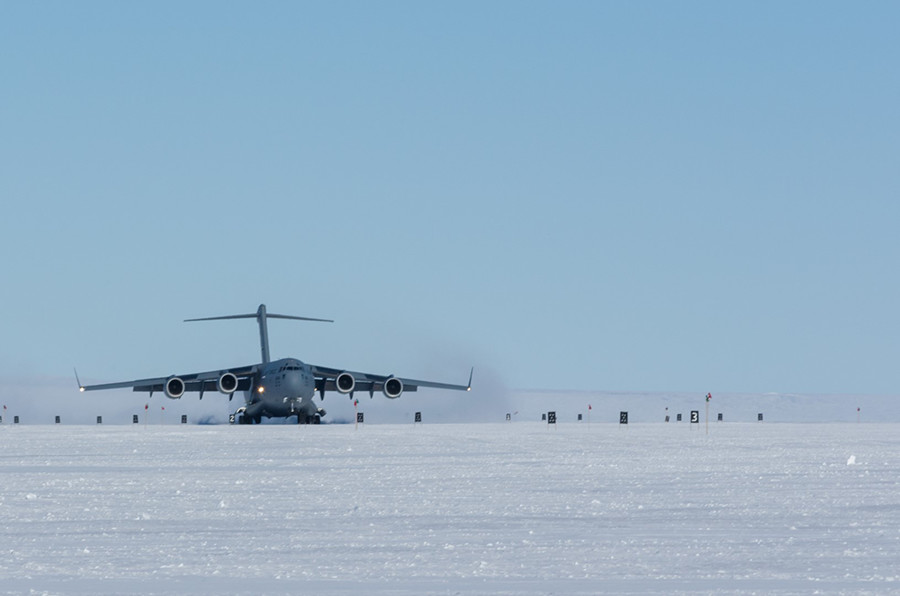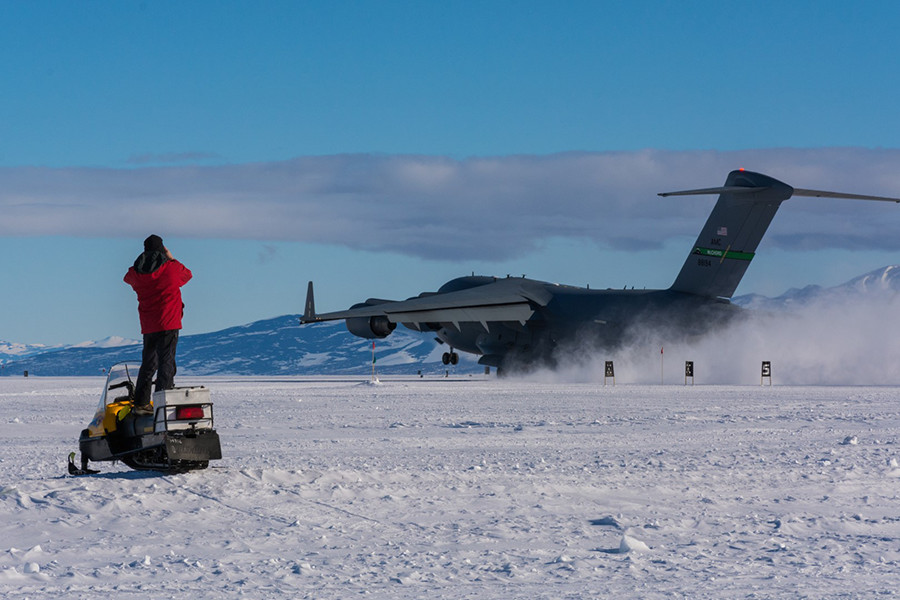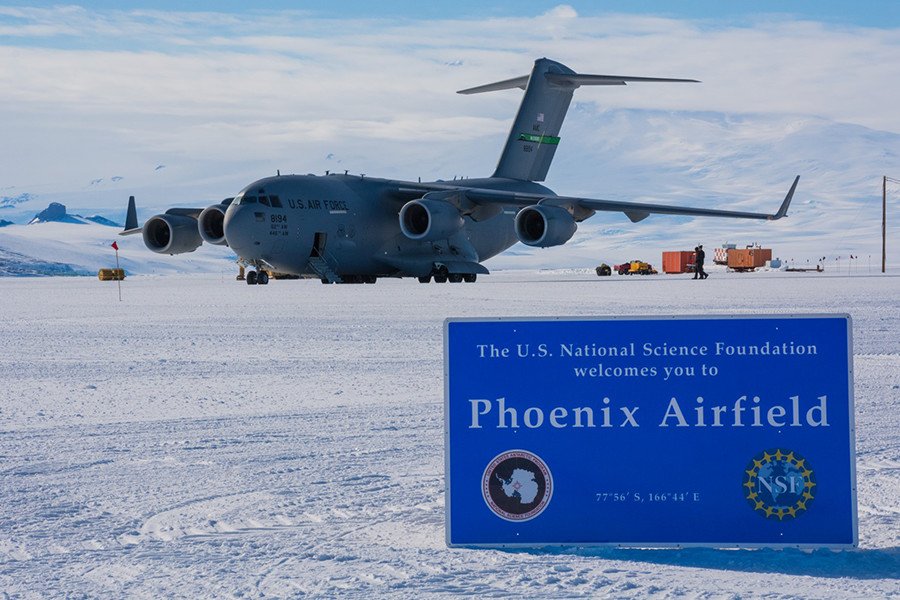
Photo Credit: Mike Lucibella
|
A C-17 touches down on the Phoenix Airfield, the first landing of a wheeled aircraft on the new landing strip.
|
Phoenix Rising
McMurdo Station’s Newest Airfield Passes its Biggest Test
By Michael Lucibella, Antarctic Sun Editor
Posted November 21, 2016
When a C-17 cargo plane landed at McMurdo Station’s recently completed Phoenix runway on Tuesday, Nov. 15, it meant that the station’s newest airfield had passed its final test and is now ready to receive planes and passengers from the U.S. Antarctic Program’s port of departure in New Zealand as early as February.

Photo Credit: Mike Lucibella
A member of ground crew directs a C-17 as it performs a series of test maneuvers in its parking area after landing at the Phoenix Airfield.
The new runway is designed to be able to withstand roughly 60 flights a year from the various wheeled planes that visit the National Science Foundation’s McMurdo Station, the U.S. Antarctic Program’s logistic hub on Ross Island.
“After three-plus years of preparation, it was very satisfying to see the hard work and planning of so many come together,” said Maggie Knuth, operations manager for the NSF-managed Antarctic Program.
The Phoenix runway is a unique landing strip, even for Antarctica. Unlike conventional runways in much of the rest of the world, there’s no concrete or asphalt surface for the plane to touch down on. Other landing strips in polar regions, like Pegasus, use a hard ice surface to support the planes that land.
The surface and foundation of the Phoenix runway is made of snow that’s been compacted by heavy rollers weighing up to 160,000 pounds. This crushes the snowflakes down into dense layers, nearly as hard as concrete. As new snow falls onto the field, it too will be crushed down to the hard landing surface. No other airfield in the world uses deep compacted snow to land wheeled airplanes.
“Phoenix is one of a kind,” said George Blaisdell, a research civil engineer with the U.S. Army’s Cold Regions Research and Engineering Laboratory.

Photo Credit: Mike Lucibella
George Blaisdell watches from his snowmobile as a C-17 takes off from the new Phoenix Airfield. After withstanding two takeoffs, two landings and a series of taxiing maneuvers, the new airfield is certified safe for wheeled aircraft.
Phoenix is slated to replace the existing Pegasus White Ice Runway, which has supported the landing of wheeled aircraft for 26 years. This means that in upcoming seasons, the program’s largest planes, which carry the most cargo and passengers, should be able to safely land throughout much of the season.
“This new runway will allow us to retire Pegasus airfield,” Knuth said. “After many years of service it had become less reliable in supporting the program’s wheeled airlift needs at the end of the summer season. Phoenix will be open and operated conservatively to start, but I hope someday that we can stretch wheeled operations further into the summer months and allow the LC-130s to stay on continent supporting the science mission.”
The construction teams had been building and testing the strength of the compacted snow runway for 15 months to ensure it would be ready to service a C-17 weighing more than 500,000 pounds.
“The test [results] were outstanding,” said Blaisdell. “We wanted to validate that the certification measurements that we took last week were accurate and translated to safely supporting a C-17.”
The final test was to have an actual C-17 perform a series of maneuvers on the airfield. After first dropping off its passengers and cargo at Pegasus airfield four miles away, the C-17 landed at Phoenix, taxied around its parking apron, took off, flew back around to land at Phoenix again, parked for about half an hour on the apron, backed up and then took off again to return to Pegasus.
“The maneuvers were planned to create the highest possible impact to the runway, to leave no doubt in the pilots’ minds that the airfield was prepared to their high standards,” Knuth said. “Each one was executed perfectly by the aircrews and resulted in minimal surface disturbance (similar to what we see at the Pegasus White Ice Runway) and zero pavement failures.”

Photo Credit: Mike Lucibella
A C-17 idles at the new Phoenix Airfield, testing the strength of its parking apron. It’s hoped that the new airfield can be used as early as February to redeploy McMurdo residents.
Currently, C-17 cargo and passenger flights from New Zealand typically end in late November, and don’t resume until the very end of the season in February. Warm temperatures and direct sunlight during the peak of summer lead to poor ice conditions at Pegasus.
The nearby Williams Field Ski-way had been filling in the gap by supporting the smaller, ski-equipped LC-130s arriving from Christchurch. However Williams Field is unable to support the larger wheeled airframes like C-17s, Airbus 319s and Boeing 757s. This limitation has led to a bottleneck for passengers and cargo during the peak of the summer season.
“[Phoenix] maintains [the Antarctic Program’s] capability,” Blaisdell said. “It’ll give [the program] access to wheeled aircraft for nearly the entire year.”
The construction techniques developed at the Phoenix site were designed to overcome some of the challenges that have cropped up over the years with the Pegasus runway.
Pegasus runway was built on the McMurdo Ice Shelf in a location protected from excessive snow accumulation, as well as mineral dust that blows off of nearby Black Island. However unlike solid earth, the ice shelf floats on the ocean, and is constantly moving.
As the ice shelf moves, it takes the Pegasus runway along with it. The runway travels about 140 feet per year, or about two-thirds of a mile over the 26 years it’s been in operation.
This movement now places Pegasus runway in a region of the ice shelf that does not sustain a snow cover and where strong melting occurs during the peak of summer. It has now moved into an area where the mineral matter that is scoured off Black Island by the moving ice shelf, and blown off by strong winds, collects on the ice surface. Unlike white snow and ice, these dark-colored particulates absorbed the rays of the sun causing them to heat up and melt the top layers of ice on the runway. In recent years, pools of melted ice have formed along the Pegasus runway, hampering operations.
The Phoenix runway was built about three miles away from Pegasus in an area away from much of the melting problems plaguing Pegasus. Importantly, it’s in a region that gets on average about 1.5 feet of snow accumulation per year, which helps mitigate any dust that does deposit on the runway. The snow is effectively new building material the heavy equipment operators will use to cover up any dark particulates that appear on the field.








